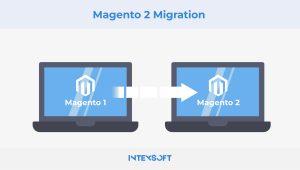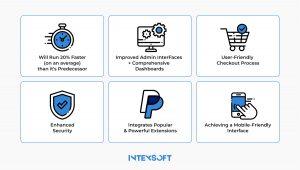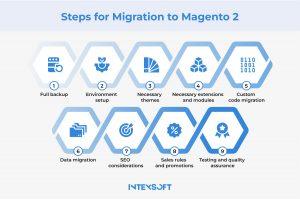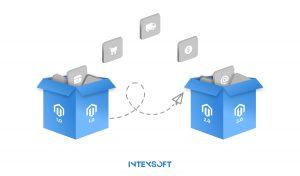Magento 1 to Magento 2 Migration in 2023


This article outlines migrating from Magento 1 to Magento 2 in 2023. It showcases the advantages of Magento 2.
Reading time: 29 min.

Magento (Adobe Commerce) is a leading eCommerce platform known for its flexibility and robust features. The first version of the software was called Magento 1, and after a decade of its debut, the second, updated version, Magento 2, was released. If you are interested in Magento e-commerce development, then the issue of migrating from Magento 1 to Magento 2 becomes relevant for you now. Below, we will explore the differences between the two platforms, the Magento migration process for complete migration immediately, including a dry run to ensure a smooth transition, the advantages of Magento 2, and guide you on how to transfer your online store from one version of the platform to the other.
You might want to migrate your eCommerce store from Magento 1 to Magento 2 — from outdated design and poor performance to dissatisfaction with speed. But the main reason for a successful migration from Magento 1 to the new platform is that it has become necessary. Since 2020, Adobe has stopped supporting the Magento 1 version, resulting in discontinued updates and fixes for outdated data. Therefore, upgrading to the latest Magento version is crucial to ensure optimal performance and ongoing official support.
Naturally, then, the security systems of online stores running on Magento 1, a legacy software, have turned out to be extremely vulnerable to cyberattacks. To mitigate such a situation happening to your online store and ensure the protection of critical data and network access, migrating to Magento 2 has become an important and necessary step.
Magento was initially developed as a flexible eCommerce solution. However, the platform’s first version did not have some critical features and was notable for its slow speed. The goals driving the development of Magento 2 included solving these problems and creating several advantages built into the new version. Let’s take a look at the difference between Magento 1 and Magento 2, including migration data, configuration files, the Magento migration service, the latest updates, and improved features such as faster loading times, enhanced performance, better scalability, improved checkout process, and additional functionalities like compared products.
| Magento 1 | Magento 2 | |
| PHP 5.2, partial support PHP 5.3, PHP 5.4 | Programming languages | PHP 5.5, PHP 5.6.3, PHP 7.0.13, HHVM 53 |
| Incompatibility with scaling technologies. | Scalability | MySQL Percona technology for performance and scalability. |
| Reduced productivity and speed when handling numerous orders. | Performance | Load balancers. Page loading speed is 50% faster. Performance optimization, server response time reduction. Performance testing. |
| Lack of ready-made solutions for SEO. | SEO | Availability of ready-made modules for SEO. |
| No longer updating security systems. | Security | Security updates and system bug fixes. |
| Conflicts when installing two or more extensions with similar functionality. | Extensions | Simplified process for installing extensions and updates. |
| Outdated templates, non-responsive design. | Design | Modern templates adaptable to any site content and device. |
| Lack of design for mobile devices. | Responsiveness | Responsive design for mobile devices. |
Based on the aspects and new features we have considered, many of the advantages of Magento 2 are already evident:
However, let’s dive in a little further and take a closer look at the main benefits of Magento’s latest version, including advanced login credentials, access keys, the installation of the data migration tool, the root directory, migrated data, and using Magento Composer with HTTPS, and the upgrade command.
The current version of Magento has a comprehensive technology stack that significantly speeds up work, optimizes performance, and expands the platform’s functionality. However, it’s important to note that Magento 2 has a different structure and incorporates diverse technologies.
The Magento 2 tech stack includes Apache, HTML5, CSS3, JQuery, RequireJS, Knockout.js, NGINX, Varnish, Composer, Symfony, Redis, and more. This updated tech stack provides improved performance and enhanced capabilities to meet the evolving needs of modern e-commerce businesses.
Magento 2 can integrate with modules such as CRM, payment gateways, reports and analytics, external applications, etc.
The new version of the platform also provides the introduction of useful marketing and SEO functions, working with business metrics without manual checking, and reporting tracking from the admin panel. Additionally, ensure that the connector installation for the data migration tool is appropriately executed to facilitate the seamless transfer of data and maintain the functionality of these new features in the Magento 2 platform.
The admin account and panel have been significantly improved, making it more intuitive and, therefore, more accessible for owners to use and navigate their business operations.
An important moment in expanding the functionality of Magento 2 was the introduction of Ajax Add-To-Cart technology. This tech allows you to skip reloading the page when adding a new product to the cart, which significantly increases the speed of site performance — and elevates the convenience of using the store for the buyer.
As we mentioned above, the discontinuation of updates for Magento 1 is already a considerable threat to your online store should you continue relying on the older software. In addition to the fact that the latest security updates for Magento 2 will continue to be released, the new version supports advanced built-in options. For example, the SHA-256 secure hashing algorithm and the built-in Signifyd anti-fraud system.
To prepare for the migration process, you need to complete the following actions:

You have the option to either try a demo migration or proceed with a full Magento 1 to Magento 2 data migration right away. To experience the demo migration, initiate the process with a limited number of entities, allowing you to preview the actions involved, similar to the actual migration. If you prefer to perform the full migration immediately, click on the “Skip Demo Migration” button. After the migration is completed, you will receive an email notification from the LitExtension system. You can then visit your Target Store to verify the result and ensure your data has successfully been transferred to your desired store. Navigate to the target store’s root folder and check the result. You can also download a zip file containing the migrated data for further reference.

Cease operations. Temporarily halt all activities within the Magento 1.x Admin Panel, except for order management tasks like shipping, payment, tax settings, and creating invoices and credit memos. Refraining from resuming such tasks is crucial until the Magento 2 stores are fully live and operational.
It is advisable to halt all Magento 1.x cron jobs temporarily. This action helps prevent any potential conflicts or interruptions during the migration process. By following command, you can focus on the migration without any interference from scheduled tasks. Once the migration to Magento 2 is completed after final verification, you can resume the cron jobs to restore the regular automated tasks in your new Magento 2 environment.
For the most up-to-date versions of extensions, visit the Commerce Marketplace or get in touch with your extension provider. When it comes to migrating your database assets from extensions, kindly specify which specific assets you would like to transfer during the migration process. This will ensure a targeted and efficient migration tailored to your needs.
What steps to migrate will be required to complete this process and solve important problems? We’ve got you covered with the below steps. So, assuming you are fully convinced that your Magento store needs to migrate data from Magento 1 to Magento 2, how do you go about it? Run the following steps to successfully migrate your data:
Step 1: Create a full backup as one of the critical migration steps
To begin the migration process, follow step 1. Create an archive of all your Magento 1 store data, including customers, recently viewed products, payment data, CMS pages, product descriptions, marketing, SEO data, and any third-party information, along with the associated product IDs. This step is crucial to ensure the safety and integrity of your data throughout the migration process. Creating a comprehensive archive allows you to easily reference and transfer the necessary information from the old platform to the new one.
Step 2: Environment setup as a stable foundation
To ensure a smooth migration process, follow step 2. Install Magento 2 on the same hosting server or a new environment, considering the compatibility with the server requirements. Additionally, make sure to configure the relevant directory permissions to ensure the proper functioning of Magento 2. By carefully setting up the environment, ensuring compatibility, and configuring proper permissions, you can create a stable foundation for the migration process.
Step 3: Preparing the necessary Magento 1 theme for the site
Unfortunately, it is impossible to fully migrate your store theme from Magento 1 to Magento 2. That being said, to keep the look and feel of your store to suit your needs, it is possible to customize existing Magento 2 themes or create a new theme of your own with the help of for-hire experts. In step 3, you can collaborate with experts to define the desired theme and implement the necessary customizations.
Step 4: Prepare the necessary extensions and modules
When migrating from Magento 1 to Magento 2, it’s impossible to integrate identical extensions. However, Magento development specialists can help with extension migration by integrating or developing new extensions and modules for your new site. They have expertise in Magento extensions and can ensure a smooth integration process.
Media files, such as images and videos, need to be manually transferred during the full migration to maintain the visual assets of your store.
Working with specialists ensures a professional and efficient migration process, including handling third-party extensions and developing custom solutions.
You have to pay attention to the following:
Step 5: Custom code migration
Magento is an open-source platform. Paying attention to the safe migration of custom code from Magento 1 to Magento 2 is an important part of the migration process. Ensure the above code is properly reviewed, updated, and tested for compatibility with Magento 2.
Step 6: Perform data migration
Export the Magento 1 database and import it into the Magento 2 database using the vendor Magento data migration tool, such as the LitExtension Connector. This tool utilizes mapping files provided by Magento to accurately transfer the data from your live store, including multiple languages if applicable. Once the migration is complete, thoroughly test the functionality of your cloned database on the target store. Ensure there are no failures or errors on the migration page. Click Create New Migration button to start (the top right button on the screen). Validate the successful adaptation of your site to the structure of the new Magento 2 platform.
Stop incremental migration processes from Magento 1 to Magento 2 to avoid conflicts during the transition.
Following the provided documentation, utilize the vendor Magento data migration tool to migrate data from Magento 1 to Magento 2. Review and update the composer config repositories to include the necessary dependencies for Magento 2.
The data migration process also includes incremental data migration and data updates. It would be best if you did the following:
Step 7: SEO considerations to provide the most beneficial SEO effect
Update the Google Search Console and Google Analytics settings for your source cart and resubmit the website sitemap to maintain search engine visibility during the transition.
Implement 301 redirects for any changed URLs to preserve SEO rankings and seamlessly redirect users to the corresponding field in the new website structure.
Update the Google Search Console and Google Analytics settings for your source cart, including performing an SEO analysis and monitoring website traffic. This analysis can help identify high-performing keywords and optimize your content accordingly.
Additionally, resubmit the website sitemap to maintain search engine visibility during the transition. To preserve SEO rankings, you must implement 301 redirects for any changed URLs, including SEO URLs, to ensure a smooth user experience and maintain rankings. By closely monitoring your SEO performance and making necessary adjustments, you can ensure that your website continues to rank well and attract organic traffic even after the transition.
Step 8: Sales rules and promotions for your custom development new website
Recreate any sales rules, upgrades, and pricing system configurations in the Magento 2 admin panel. Verify that the rules and promotions are working as intended.
During the transition, you can focus on various aspects, such as design customization, exploring the new admin panel, and leveraging new SEO features. It’s important to note that your old store will continue to remain active, allowing you to receive orders and update new products in the products section. Rest assured; the migration process will not impact your sales activity on the open-source store in any way.
Step 9: Testing and quality assurance automatically checked
Explore the seamless integration and enhanced features through an insightful video tutorial, providing a comprehensive preview of the Magento 2 installation process.
Now, the last step. Perform a demo migration in a test environment to identify any issues or errors. Thoroughly test the functionality of the Magento 2 store, including checkout, payment gateways, shipping, and customer accounts. Validate the migration by cross-checking the data integrity between Magento 1 and Magento 2.
Initiate the demonstration migration by selecting a limited number of entities to transfer, performing the same actions, and select additional options as needed.
You have to do the following commands:
By following steps, you can successfully transition from Magento 1 to Magento 2, taking into account factors such as secure key pairs, data migration, extension compatibility, incremental data transfer, and rigorous testing. Always refer to the official documentation and seek assistance from Magento experts.
You initiated Magento 2 cron jobs to ensure smooth and timely task scheduling. Stop incremental updates by pressing Ctrl + C in the migration tool command window, allowing for a pause in the migration process. Optimize Performance – re-index the Magento 2 stock indexer to enhance data retrieval speed and efficiency. Cache pages in Magento 2, boosting website performance and delivering seamless browsing for your customers. Thoroughly test the Magento 2 site in the staging environment, ensuring you can save config and all functionalities are in optimal condition for the final launch. Verify the following directories and make necessary adjustments, including any new production hardware, to ensure smooth operation.
Once all these steps are completed, you will receive a success message indicating that your Magento 2 store is now fully operational. Change DNS settings to precisely point to the Magento 2 production environment, making your store live and ready to serve customers. Embark on the next chapter of your e-commerce journey with confidence and efficiency as your Magento 2 store comes to life.
When you install the data migration tool, you have to configure files for the data migration tool. The Magento Data Migration Tool offers a unique feature by diligently preserving its progress. In the event of any unexpected errors, it promptly halts the migration process and seamlessly resumes from the last known good state. Moreover, during the migration, this remarkable tool may provide comprehensive error reporting to ensure a smooth transition.

Let’s look at a few data migration tools that can greatly facilitate the migration process — both for Magento migration as well as for other platforms (Drupal, WordPress). This will help you to choose the appropriate option. Use the data migration tool version to benefit.
Data Migration Tool is a command-line interface for Magento 1 to Magento 2 data transfer and migration of important media files.
Code Migration Toolkit is a Magento data migration tool package for converting custom Magento 1 code to Magento 2.
Fivetran is an automated data integration tool to help you with theme migration.
Hevo Data is a tool that allows replicating from over 150 sources to a destination of your choice.
Matillion is a cloud platform that allows you to move data by migrating, extracting, and transforming your data in the cloud.
You have to configure data migration tool.
One important consideration is to ensure that the chosen data migration tool supports delta mode and maintenance mode. Delta mode enables the tool to incrementally capture data updates (such as new orders or reviews), allowing you to transfer only the changes made since the initial migration, reducing the migration time for incremental updates. Maintenance mode, on the other hand, provides a way to temporarily suspend data migration operations while performing maintenance tasks, such as database optimizations or system upgrades. This ensures that the migration process does not interfere with ongoing maintenance activities and helps maintain the overall stability and advanced performance of the system.
To update the location of the Data Migration Tool package in the composer JSON file within the root dir of Magento 2, do the following CLI command:
Make sure to perform these steps in the above file.
By following these steps and updating any required files manually, you will successfully update the location of the Data Migration Tool package in the composer.json file, allowing you to utilize the desired Magento 2 version.
Next, let’s look at what problems you’re likely to encounter when migrating your site from Magento 1 to Magento 2.
The loss of all your data about products, order customers, and other essential information is the most common issue when migrating from one platform to another. That is why we strongly recommend that you remember to back up migrate products, as well as any other transferring data that is important to your store. By ensuring a comprehensive backup and successful migration of your products, you can safeguard against potential loss and ensure a smooth transition to the new platform.
If your site on Magento 1 continues to work during the migration process, be prepared that — with a poorly optimized store process — it will negatively affect the site loading speed.
Keep in mind that during the migration, the URLs of your site’s pages will change. We recommend setting up a 301 redirect to avoid errors.
Magento migration is a complex process in itself. At the very least, the cost of development will include the services of a team of specialists. In addition, the Magento cost depends on the requirements that your business needs, such as themes, designs, extensions, etc.
In 2022 (and beyond), it is truly worth it to upgrade Magento 2 is more of a necessity than a whim. The advantages of Magento 2 over Magento 1 are evident, especially considering the end-of-life status of Magento 1. Migrating to Magento 2 will not only accelerate the speed of your online eCommerce store and boost productivity, but it will also significantly increase the profits of your business. This is due to the buyer and user-friendly interface and Magento 2’s adaptability to mobile devices, enabling a seamless shopping experience for your customers.
For more information and helpful resources on Magento 2 migration and eCommerce best practices and examples, make sure to visit our blog.
The process of Magento migration is no easy task. It involves complexities that require a professional approach. IntexSoft specialists are ready to help you move your store and migrate data from Magento 1 to Magento 2, considering the migration possibility and executing the switch immediately while considering all the aspects your business needs. If you have any questions or need guidance regarding your Magento version, code migration toolkit, database host, or migration settings, you can always contact us for a consultation.